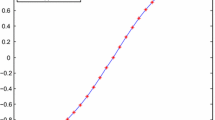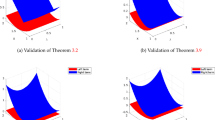Abstract
In this paper, the theoretical convergence rate of the Sinc indefinite integration combined with the double-exponential (DE) transformation is given for a class of functions for which the single-exponential (SE) transformation is suitable. Although the DE transformation is considered as an enhanced version of the SE transformation for Sinc-related methods, the function space for which the DE transformation is suitable is smaller than that for SE, and therefore, there exist some examples such that the DE transformation is not better than the SE transformation. Even in such cases, however, some numerical observations in the literature suggest that there is almost no difference in the convergence rates of SE and DE. In fact, recently, the observations have been theoretically explained for two explicit approximation formulas: the Sinc quadrature and the Sinc approximation. The conclusion is that in such cases, the DE’s rate is slightly lower, but almost the same as that of the SE. The contribution of this study is the derivation of the same conclusion for the Sinc indefinite integration. Numerical examples that support the theoretical result are also provided.








Similar content being viewed by others
Notes
This is taken from Okayama et al. [5, Example 9.6].
References
Haber, S.: Two formulas for numerical indefinite integration. Math. Comput. 60, 279–296 (1993)
Mori, M., Sugihara, M.: The double-exponential transformation in numerical analysis. J. Comput. Appl. Math. 127, 287–296 (2001)
Muhammad, M., Mori, M.: Double exponential formulas for numerical indefinite integration. J. Comput. Appl. Math. 161, 431–448 (2003)
Okayama, T., Matsuo, T., Masaaki, S.: Approximate formulae for fractional derivatives by means of Sinc methods. J. Concr. Appl. Math. 8, 470–488 (2010)
Okayama, T., Matsuo, T., Sugihara, M.: Improvement of a Sinc-collocation method for Fredholm integral equations of the second kind. BIT Numer. Math. 51, 339–366 (2011)
Okayama, T., Matsuo, T., Sugihara, M.: Error estimates with explicit constants for Sinc approximation, Sinc quadrature and Sinc indefinite integration. Numer. Math. (2013). doi:10.1007/s00211-013-0515-y
Okayama, T., Tanaka, K., Matsuo, T., Sugihara, M.: DE-Sinc methods have almost the same convergence property as SE-Sinc methods even for a family of functions fitting the SE-Sinc methods. Part I: Definite integration and function approximation. Numer. Math. (2013). doi:10.1007/s00211-013-0540-x
Stenger, F.: Numerical Methods Based on Sinc and Analytic Functions. Springer, New York (1993)
Stenger, F.: Summary of Sinc numerical methods. J. Comput. Appl. Math. 121, 379–420 (2000)
Sugihara, M., Matsuo, T.: Recent developments of the Sinc numerical methods. J. Comput. Appl. Math. 164–165, 673–689 (2004)
Tanaka, K., Sugihara, M., Murota, K.: Numerical indefinite integration by double exponential sinc method. Math. Comput. 74, 655–679 (2005)
Tanaka, K., Sugihara, M., Murota, K.: Function classes for successful DE-Sinc approximations. Math. Comput. 78, 1553–1571 (2009)
Tanaka, K., Sugihara, M., Murota, K., Mori, M.: Function classes for double exponential integration formulas. Numer. Math. 111, 631–655 (2009)
Author information
Authors and Affiliations
Corresponding author
Additional information
This work was supported by JSPS Grants-in-Aid for Scientific Research. Part of this work was done while the second author visited Future University Hakodate in the summer of 2011 using its summer stay program.
Rights and permissions
About this article
Cite this article
Tanaka, K., Okayama, T., Matsuo, T. et al. DE-Sinc methods have almost the same convergence property as SE-Sinc methods even for a family of functions fitting the SE-Sinc methods. Numer. Math. 125, 545–568 (2013). https://doi.org/10.1007/s00211-013-0541-9
Received:
Revised:
Published:
Issue Date:
DOI: https://doi.org/10.1007/s00211-013-0541-9




